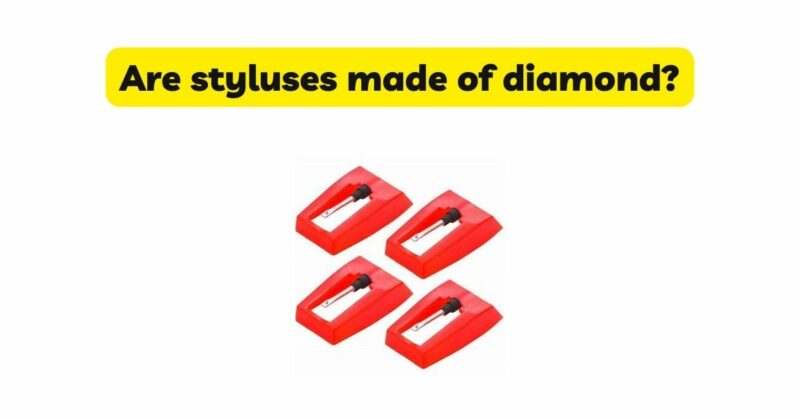Diamonds have long been associated with elegance, luxury, and exceptional quality. The use of diamonds in various industries has sparked curiosity and speculation, including their potential incorporation in styluses for record players. In this article, we will delve into the truth behind the use of diamonds in styluses, exploring the different types of styluses available, the advantages and drawbacks of diamond-tipped styluses, and the considerations involved in their implementation.
- Understanding Styluses and Their Importance: The stylus, also known as the needle, is a crucial component of a record player, responsible for translating the physical grooves on vinyl records into sound vibrations. The quality and design of the stylus directly impact the accuracy of sound reproduction, tracking ability, and overall performance of the record player.
- Common Stylus Materials: Styluses have been made from various materials throughout history, with each material offering different characteristics and performance levels. Common stylus materials include steel, sapphire, diamond, and diamond-coated options. The choice of material depends on factors such as cost, durability, compatibility with different record types, and desired sound quality.
- Steel and Sapphire Styluses: Steel and sapphire styluses were commonly used in older record players. Steel styluses were simple, inexpensive, and readily available, but they exhibited limitations such as increased record wear and reduced sound quality. Sapphire styluses offered improved tracking ability and reduced record wear compared to steel, but they did not incorporate genuine diamonds.
- Diamond-Coated Styluses: Diamond-coated styluses offer an alternative approach to incorporating diamonds in stylus construction. These styluses feature a metal or alloy core with a thin layer of synthetic diamond coating applied to the tip. The diamond coating enhances durability, reduces record wear, and improves tracking accuracy. While diamond-coated styluses provide benefits similar to diamond-tipped styluses, they do not use genuine diamonds as the core material.
- Genuine Diamond Styluses: While genuine diamond-tipped styluses exist, they are not commonly found in mainstream record players. Genuine diamond styluses are primarily used in specialized applications, professional audio setups, and high-end turntables that prioritize the utmost precision, accuracy, and longevity. These styluses typically utilize either natural or synthetic diamonds.
- Natural Diamond Styluses: Natural diamond styluses, featuring diamond tips made from natural diamonds, are exceptionally rare and expensive. The scarcity and high cost associated with natural diamonds make them impractical for widespread use in most record players. They are often reserved for custom-built turntables, audiophile-grade equipment, and professional settings where the highest level of performance is required.
- Synthetic Diamond Styluses: Synthetic diamonds, created in laboratories, offer a more accessible and affordable option for incorporating diamonds in styluses. Synthetic diamond styluses provide comparable hardness, durability, and performance to natural diamonds, making them a suitable alternative. However, even synthetic diamond styluses are not commonly found in mainstream consumer-grade record players due to their higher cost compared to other stylus materials.
- Considerations for Material Selection: The choice of stylus material depends on several factors, including cost, desired sound quality, tracking ability, record compatibility, and market segment. Manufacturers carefully consider these factors when selecting the most suitable material for a stylus. While diamonds may offer exceptional performance, their high cost often makes them less practical for everyday consumer-grade record players.
- Consumer-Grade Record Players: Consumer-grade record players, designed for casual listeners and everyday use, typically do not incorporate genuine diamonds in their styluses. These record players often utilize alternative materials like steel, sapphire, or diamond-coated styluses to provide satisfactory sound reproduction and durability at an affordable price point. The focus is on delivering an enjoyable listening experience without the added expense associated with diamond styluses.
- High-End and Professional Applications: In high-end audio systems and professional settings, genuine diamond styluses may be employed to achieve the pinnacle of performance and sound quality. These styluses prioritize accuracy, minimal record wear, and exceptional sound reproduction. Genuine diamond styluses are often found in top-of-the-line cartridges and stylus assemblies designed for audiophiles, music studios, DJs, and professionals who demand the utmost precision and fidelity.
Conclusion: While diamonds have an undeniable allure and association with luxury, genuine diamond styluses are not commonly used in mainstream consumer-grade record players. Alternative materials like steel, sapphire, and diamond-coated styluses provide satisfactory performance and durability at more accessible price points. The incorporation of genuine diamonds in styluses is primarily reserved for specialized applications, high-end turntables, and professional audio setups where ultimate precision and accuracy are paramount. Understanding the range of stylus materials available allows consumers to make informed choices when selecting a record player that meets their needs, preferences, and budget. Regardless of the material used, record players continue to offer a captivating and immersive musical experience, allowing individuals to enjoy the magic of vinyl records in their own homes.


